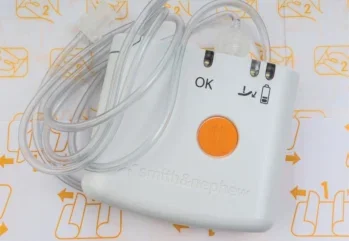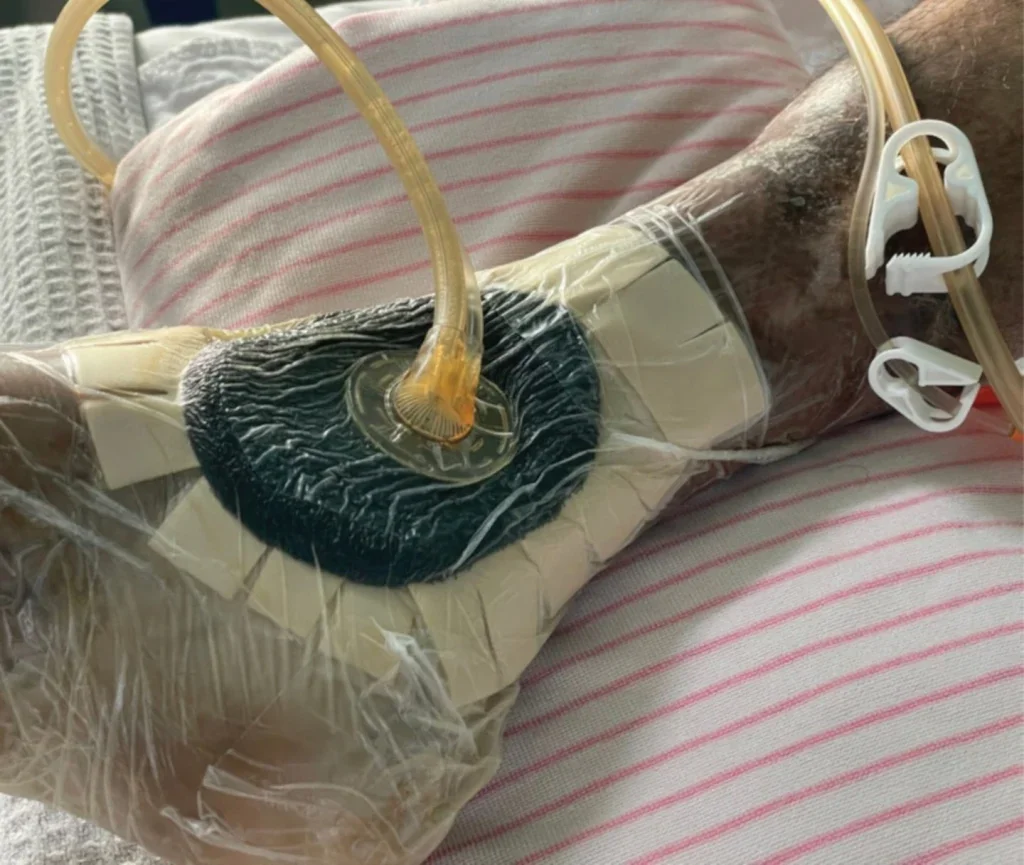
The technology is nothing new, the positives for patients are proven and a clear case can be made for the economic benefits. Yet the use of negative pressure wound therapy (NPWT) is not nearly as widespread as it could – or should – be.
That is the view of many clinicians who have seen first-hand the benefits of this relatively simple process of applying a dressing to a wound, covering it with a transparent film, and then using an NPWT device to lower the pressure on the wound side, draw away excess fluid, thus creating an environment in which the wound can heal faster and with greatly reduced risk of infection. Removing the pressure on the surface of a wound created by gasses in the air around us – the principle behind vacuum-assisted wound closure – allows fluid to be gently pulled from the wound over time, reducing swelling, cleaning the site and encouraging the movement of lymph.
NPWT also acts to pull the edges of a wound together, potentially stimulating the growth of new tissue. Its effectiveness has led to more countries making it accessible, with France and Germany the latest European states to introduce reimbursement policies for NPWT, though it has been available in other states, notably Portugal, for a long time.
“The increasing adoption of NPWT can be attributed to its proven clinical benefits, such as faster wound healing, reduced complication rates and improved patient outcomes,” notes Professor Alexandre Rodrigues at Portugal’s University of Aveiro. “It is also interesting in terms of costeffectiveness. While the initial investment in NPWT devices may be higher, the potential for reduced hospital stays, fewer complications, and faster patient recovery can lead to significant cost savings in the long run.”
“Modern NPWT devices are also designed to be user-friendly and intuitive, with easy-tounderstand controls and clear instructions.”
Maria Guedes
Numerous studies have shown that NPWT accelerates healing, reduces the length of hospital stays and improves clinical outcomes, and this evidence-based efficacy has driven its adoption in clinical settings. Rodrigues also points out the growing awareness among healthcare professionals about its benefits, yet there are still obstacles slowing down wider use.

Saving money, saving lives
From the large vacuum pumps used in acute settings, to the portable pumps that can be used in ambulatory care, and the single-use disposable devices that allow patients full mobility, NPWT is versatile in its application, and has the potential to reduce costs, as well as improve clinical outcomes. Many NPWT devices are portable and lightweight, making them suitable for home use.
Patients can benefit from faster healing, reduced pain and improved quality of life, sometimes while receiving treatment in their own homes. The continuous evacuation of fluids and contaminants, can greatly reduce bacterial load, making NPWT a vital tool for preventing infection, particularly in deep and complex wounds. With fewer complications, such as infections or delays to the healing process, cost savings accrue. Returning patients to their daily lives sooner also reduced the economic burden that chronic wounds can incur, all while improving patient satisfaction.
“Modern NPWT devices are also designed to be userfriendly and intuitive, with easy-to-understand controls and clear instructions,” explains Maria Guedes, a specialist in tissue viability at the Duorum Saúde Clinic in Vila Nova de Gaia, Portugal. “These designs help to minimise the risk of errors and ensure consistent application of NPWT. Also, the devices include sensors that monitor pressure and provide feedback in realtime, helping with alerts from incorrect use.”
At another site in Portugal – the São João University Hospital in Porto, which is the biggest centre for cardiac surgery in the Iberian Peninsula – Viviana Gonçalves, a specialist nurse practitioner in complex wound care, uses NPWT to dramatically improve outcomes for in acute cases, including surgery on newborns. As she manages wounds after cardiac surgery, the use of NPWT is routine.
“The hospital is a centre of excellence for adult heart transplants and the treatment of cardiopathies in children,” she explains. “In 2015, we started to develop programmes and protocols for the prevention of site infection, as we had many patients developing infections, and the economic burden was very high. Since then, we have developed protocols for everyone from neonates and paediatrics to adults. Now, we are seeing very few infections and no deaths, so it is a huge win.”
For Gonçalves, the key benefit of NPWT is in preventing infections. Treating an infection once it has set is far more expensive and involves much larger, costlier equipment, as well as longer hospital stays and courses of antibiotics. “Using NPWT for infection prevention means that after seven days we can often take off all sutures from cardiac surgery as wound is fully closed,” she remarks. “People are going home in as little as five days after cardiac surgery.”
With such successful programmes in place, one huge question rears its head – why is NPWT for infection prevention not used in healthcare systems across the world as a matter of course?
Prevention versus cure
It is well understood that the vacuum effect created by NPWT minimises the chance of infection in many ways. It encourages the drainage of interstitial fluids that contribute to inflammation and oedema, it improves local blood circulation and draws more oxygenated blood to the wound site and facilitates the formation of granulation tissue. This fact is not lost on clinicians.
“We are now seeing more focus on prevention, at least in my department,” says Gonçalves. “We show the numbers to the hospital board and they clearly see the benefits and the cost savings, so we are now expanding the use of NPWT to other areas. It is now being used after C-sections and other abdominal surgeries.”
“I would like to see it used much more widely, but this is a marathon and we are still in the first five miles,” she adds. The key issue, it seems, is not a technological one – the concept is the same as ever, and the equipment has not fundamentally changed over the years – but a political and social one. The structure of healthcare systems, and the ways in which they are funded, largely determine patients’ level of access to NPWT.
Portugal, which is hardly a rich country by EU standards, has a public healthcare system that pays for everything. Patients do not pay for any treatment, and they do not have to go through any reimbursement system. “The biggest obstacle is how healthcare is structured at societal and political level,” states Gonçalves. “The reimbursement system in France and Germany has come a bit late. I worked in the UK ten years ago and it was available there, and here in Portugal we use the most expensive NPWT devices – the best machines – so the technology is affordable in other countries.”
“There are thousands of research papers on how effective NPWT is, so richer countries are a little bit late in adopting it,” she adds. “It is about national health systems. The UK and Portugal have similar systems, but France, Spain, Germany and others are different. In Austria, for example, a patient can have NWPT for four weeks, but who can say if that is long enough for any individual patient? Healing can take months.”
A time for change?
On the technology side, there is some discussion with equipment manufacturers to improve the porous foam dressings on which suction is applied, but any change in the equipment will just be tweaks. The mechanism works well, though tapes and foams could be further refined, and some would like to see the machines improve communication with clinicians, particularly if a patient is at home, to monitor compliance and stay on top of the healing progress.
The technical side, however, is a lower priority than the way in which wounds – and wound treatment – are viewed. Gonçalves is a council member of the European Wound Management Association (EWMA), which is pushing for a new approach to wound care that could see NPWT become more widely available. The organisation believes it is important for national healthcare systems to see wounds as a disease.
“Then everything changes, and you have reimbursement, but it is hard to see a wound that way,” she explains. “We are working now to see if the WHO can classify wounds as a chronic disease. There has been no response yet, but the door is open.”
“We are working now to see if the WHO can classify wounds as a chronic disease. There has been no response yet, but the door is open.”
Viviana Gonçalves
Changing how wound care is approached could have a seismic impact. The UK alone spends around more than £2bn each year on treating pressure ulcers, according to some estimates, and there are many – including Gonçalves – who feel this could be cut significantly by using NPWT more extensively.
“The future of NPWT in community care is promising,” adds Guedes. “Continued advancements in technology, coupled with increasing awareness and support from healthcare providers and policymakers, will likely drive the further expansion of NPWT services in this setting.”
Though it seems there is a long way to run before NPWT is a staple in community care settings, and much more needs to be done in order to encourage its adoption, at least we can say that the race has actually begun.





